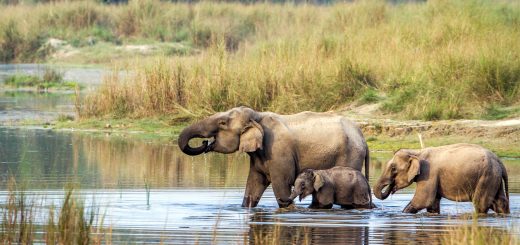Geographical Location of Nepal
Nepal, a fascinating country nestled in the heart of the Himalayas, is known for its breathtaking landscapes, rich cultural heritage, and warm hospitality. Let’s delve into Nepal’s geographical location, time zone, its complex diversity, and its relationship with neighboring countries.
Contents
Political Map of Nepal

Geographical Location:
Nepal is located in South Asia, bordered by India to the south, east, and west, and by China (Tibet Autonomous Region) to the north. Geographically, Nepal can be divided into three distinct regions: the Terai plains in the south, the mid-hills or the Mahabharat range in the central region, and the majestic Himalayas in the north.
Time Zone:
Nepal follows Nepal Standard Time (NST), which is 5 hours and 45 minutes ahead of Coordinated Universal Time (UTC+5:45). This unique time offset sets Nepal apart from most countries in the world, highlighting its individuality and independence.
| No. | Point | Description |
|---|---|---|
| 1 | Geographic Location | South Asia |
| 2 | Coordinates | 28.3949° N, 84.1240° E |
| 3 | Borders | China (Tibet Autonomous Region) to the north and India to the south, east, and west |
| 4 | Elevation | Ranges from approximately 60 meters (200 feet) in the southern Terai plains to 8,848 meters (29,029 feet) at the peak of Mount Everest |
| 5 | Mountain Ranges | Himalayas (including Mount Everest), Mahabharat Range, Chure Range, Siwalik Hills |
| 6 | Rivers | Major rivers include the Koshi, Gandaki, Karnali, and Mahakali (bordering India) |
| 7 | National Parks | Numerous national parks, including Chitwan National Park, Sagarmatha National Park, Bardia National Park, and Langtang National Park |
| 8 | Climate | Varied climates ranging from subtropical in the Terai to alpine and arctic in the high mountains |
| 9 | Biodiversity | High biodiversity with diverse flora and fauna, including endangered species like Bengal tiger, one-horned rhinoceros, and snow leopard |
| 10 | UNESCO World Heritage Sites | Kathmandu Valley (including multiple sites in Kathmandu, Patan, and Bhaktapur), Lumbini (birthplace of Lord Buddha) |
| 11 | Major Lakes | Rara Lake, Fewa Lake, Begnas Lake, Gosaikunda Lake, Tilicho Lake, among others |
| 12 | Major Cities | Kathmandu (capital), Pokhara, Lalitpur (Patan), Bhaktapur, Biratnagar, Dharan, Bharatpur, Nepalgunj |
| 13 | Population | Estimated population of over 30 million people (as of 2021) |
Complexity and Diversity:
Nepal is renowned for its cultural and ethnic diversity, with over 100 different ethnic groups and languages. The major ethnic groups include the Indo-Aryan, Tibeto-Burman, and indigenous communities. This diversity contributes to Nepal’s rich cultural heritage, traditions, languages, and customs, making it a fascinating tapestry of identities.
Neighboring Countries:
Nepal shares its borders with two neighboring countries: India and China (Tibet Autonomous Region). The long-standing relationship with these nations has influenced Nepal’s history, culture, trade, and people-to-people interactions. The open borders and close proximity to India have fostered cultural exchange, economic ties, and religious connections. Nepal’s northern border with China provides access to ancient trade routes and influences from Tibetan culture, Buddhism, and trans-Himalayan exchanges.
Relations with India:
India and Nepal share deep historical, cultural, and economic ties. The two countries have strong diplomatic relations, and the open border policy facilitates trade, tourism, and cultural exchange. People from both nations often travel across the border for various purposes, contributing to the close bonds between the two countries.
Relations with China:
Nepal China Relationship is the oldest relationship in Nepalese History. Nepal’s relationship with China has gained significance in recent years. China has become an important trade partner, investor, and development partner for Nepal. The two nations have cooperated in areas such as infrastructure development, trade, and tourism, fostering economic growth and connectivity.
Geopolitical Importance:
Nepal’s strategic location between India and China has given it geopolitical importance. Both regional powers view Nepal as a key partner in their respective spheres of influence, contributing to Nepal’s unique position in the region.
Conclusion:
Nepal’s geographical location, time zone, cultural diversity, and relationships with neighboring countries make it a fascinating and complex nation. From the peaks of the Himalayas to the plains of the Terai, Nepal’s natural beauty and rich heritage continue to enchant visitors from around the world. The country’s intricate tapestry of cultures, warm hospitality, and geopolitical significance make it a captivating destination in South Asia.







Hmm is anyone else experiencing problems with the pictures on this blog loading? I’m trying to determine if its a problem on my end or if it’s the blog. Any suggestions would be greatly appreciated.
Howdy, i read your blog occasionally and i own a similar one and i was just curious if you get a lot of spam feedback? If so how do you stop it, any plugin or anything you can suggest? I get so much lately it’s driving me insane so any assistance is very much appreciated.
I’d constantly want to be update on new blog posts on this web site, saved to favorites! .